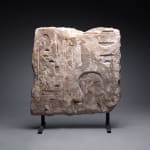Fragment with Relief Bust of Ptah, 664 BCE - 525 CE
Limestone
39.4 x 38.7 cm
15 1/2 x 15 1/4 in
15 1/2 x 15 1/4 in
PF.5360 (LSO)
This limestone fragment retains an inscription, and the profile head of Ptah (or Peteh), one of the most important gods of the Egyptian pantheon. He is believed to have dreamed...
This limestone fragment retains an inscription, and the profile head of Ptah (or Peteh), one of the most important gods of the Egyptian pantheon. He is believed to have dreamed creation and called it into being; his name literally translates as the opener, opening his mouth to call creation into existence. He is held to be the “primordial mound”, taking the physical form of a mummified man or as Apis, the bull. The markers of his office include the ankh (key to the underworld), the was (sceptre) and the djed (pillar), and he is usually represented wearing a skull cap, as in the current case.
He is intimately linked with most areas of Egyptian dynastic religion, giving rise to Atum (technically Nefertum, Atum’s younger form), becoming the specific god or protector for reincarnation, stonecutters/masons, sculptors, blacksmiths, architects, boat builders, artists, craftsmen and tomb-builders, as well as being a patron of the arts. His high priest was given the title of wr khrp hmw, "Great Leader of the Craftsmen", and his priests were probably linked to the different crafts. The opening of the mouth ceremony, designed to release spirits from their host bodies, is said to have been created by Ptah.
The preponderance of tombs (and thus masons etc) at Thebes meant that his support was particularly strong here, and he was eventually hyphenated with Seker, who was also a deity of reincarnation and craftsmen. Ptah-Seker – due to the endless evolution of religious icons – resurfaced as the husband of Sekhmet, then as the personification of the sun during night hours. The rationale for this was that the sun was nightly reincarnated through the power of the subterranean primordial mound represented by Ptah. By the Middle Kingdom he had become largely subsumed by Osiris, but the terms were evidently interchangeable as there are various references to Ptah-Seker-Osiris, the addendum designed to reflect his underworld status.
In this 26th dynasty fragment Ptah is represented with what appears to be a tunic, wearing his skullcap and elongated beard. Looking to the right, his almond shaped eyes and aquiline nose are clearly visible, though his badges of office cannot be seen. The accompanying hieroglyphic inscription is fragmentary, but reads “... beloved of Ptah, the king [unclear], the lord of heaven...”. This was probably originally a part of a tomb wall, as the numerous links Ptah has with death, resurrection, tomb-making and masonry makes him a thoroughly appropriate funerary motif. The royal link implies that the tomb may have belonged to a pharaoh or a member of his family.
This striking piece of ancient masonry is both socially and historically important, depicting a deity described by the Book of the Dead as “...a master architect, and framer of everything in the universe”. This is an unbeatable piece for the discerning collector or any refined domestic setting.
He is intimately linked with most areas of Egyptian dynastic religion, giving rise to Atum (technically Nefertum, Atum’s younger form), becoming the specific god or protector for reincarnation, stonecutters/masons, sculptors, blacksmiths, architects, boat builders, artists, craftsmen and tomb-builders, as well as being a patron of the arts. His high priest was given the title of wr khrp hmw, "Great Leader of the Craftsmen", and his priests were probably linked to the different crafts. The opening of the mouth ceremony, designed to release spirits from their host bodies, is said to have been created by Ptah.
The preponderance of tombs (and thus masons etc) at Thebes meant that his support was particularly strong here, and he was eventually hyphenated with Seker, who was also a deity of reincarnation and craftsmen. Ptah-Seker – due to the endless evolution of religious icons – resurfaced as the husband of Sekhmet, then as the personification of the sun during night hours. The rationale for this was that the sun was nightly reincarnated through the power of the subterranean primordial mound represented by Ptah. By the Middle Kingdom he had become largely subsumed by Osiris, but the terms were evidently interchangeable as there are various references to Ptah-Seker-Osiris, the addendum designed to reflect his underworld status.
In this 26th dynasty fragment Ptah is represented with what appears to be a tunic, wearing his skullcap and elongated beard. Looking to the right, his almond shaped eyes and aquiline nose are clearly visible, though his badges of office cannot be seen. The accompanying hieroglyphic inscription is fragmentary, but reads “... beloved of Ptah, the king [unclear], the lord of heaven...”. This was probably originally a part of a tomb wall, as the numerous links Ptah has with death, resurrection, tomb-making and masonry makes him a thoroughly appropriate funerary motif. The royal link implies that the tomb may have belonged to a pharaoh or a member of his family.
This striking piece of ancient masonry is both socially and historically important, depicting a deity described by the Book of the Dead as “...a master architect, and framer of everything in the universe”. This is an unbeatable piece for the discerning collector or any refined domestic setting.



